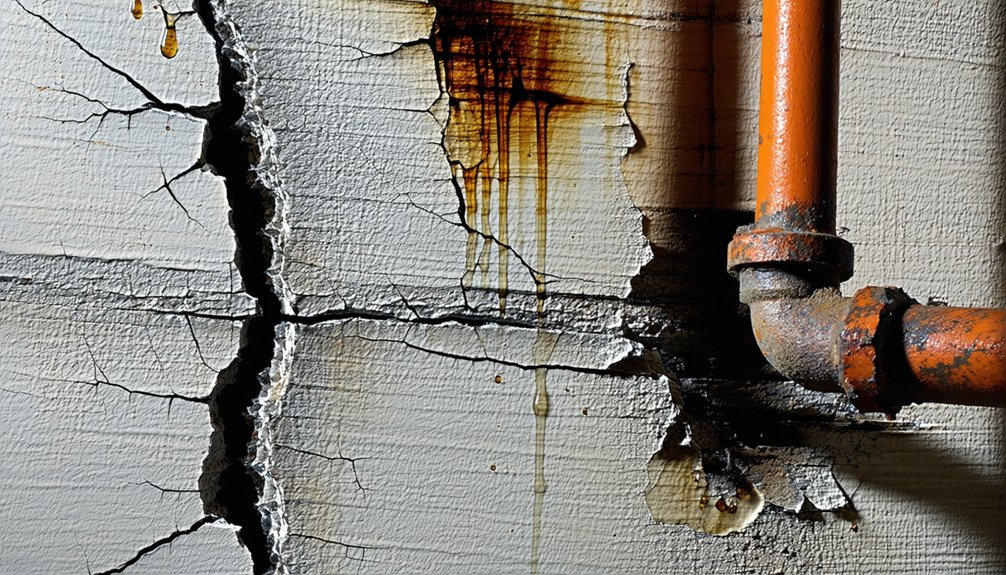Key indicators of sewer line issues include persistent backups and clogs, which often indicate serious underlying problems. Unpleasant odors and gurgling noises suggest trapped air and potential leaks. Additionally, unusual lawn growth and wet spots in the yard may indicate leaking sewer lines, as nutrients from wastewater can enhance grass development. Addressing these symptoms promptly is essential to prevent significant plumbing emergencies. Further investigation into these indicators can reveal deeper systemic issues.
Frequent Backups and Clogs
Frequent backups and clogs in plumbing systems often indicate underlying issues within the sewer line that require immediate attention. Such disruptions, particularly in toilets, often arise from tree root intrusion or the improper disposal of non-degradable items. Persistent clogs in sinks and tubs can denote deeper systemic problems rather than mere blockages, necessitating a professional evaluation. When multiple drains back up simultaneously, it typically signifies a significant obstruction in the main sewer line, which demands urgent inspection. Regular backups pose serious risks, leading to unsanitary conditions that create health hazards. Homeowners must closely monitor their plumbing systems; neglecting these symptoms can result in severe plumbing emergencies. Timely intervention is essential to mitigate further damage and restore the system's functionality, ensuring a safe and sanitary environment. Addressing frequent backups and clogs proactively can liberate homeowners from the potential chaos of escalated plumbing issues.
Unpleasant Odors and Gurgling Noises
Persistent unpleasant odors and gurgling noises from plumbing fixtures are often indicative of serious sewer line issues that warrant immediate investigation. These symptoms can signal potential blockages or ruptures that, if left unaddressed, may lead to significant health hazards and plumbing emergencies.
Persistent odors and gurgling noises from plumbing fixtures may signal urgent sewer line issues needing immediate attention.
- Sewage Smells: Foul odors in the home often indicate sewer gases escaping through damaged pipes, necessitating a professional inspection.
- Gurgling Noises: Sounds emanating from toilets or drains suggest trapped air struggling to escape, indicating an underlying blockage that could worsen plumbing issues.
- Multiple Symptoms: The combination of unpleasant odors and gurgling noises across various fixtures typically points to severe sewer line issues that demand prompt resolution.
Identifying and addressing these symptoms early can prevent extensive property damage and reduce health risks associated with sewage exposure, emphasizing the importance of timely intervention.
Unusual Lawn Growth and Wet Spots
Unusual lawn growth and the presence of wet spots can serve as critical indicators of underlying sewer line issues. Specifically, unusual green patches in the yard may suggest leaking sewer lines, as nutrients from wastewater can enhance localized grass growth. Homeowners should be vigilant for soggy spots or consistently moist areas, which often signify such leaks, potentially leading to environmental and health concerns. Grass above damaged sewer lines typically exhibits lusher and thicker growth due to moisture and nutrients seeping from the pipes. Coupled with foul odors, these lawn patches may further indicate the presence of contaminated soil from wastewater infiltration. Prompt investigation of these phenomena is vital to avert potential sewer system failures and mitigate costly repairs. Identifying and addressing these indicators proactively guarantees the health of both the landscape and the associated underground infrastructure.
Frequently Asked Questions
How Do You Tell if You Have a Sewer Line Problem?
Identifying a sewer line problem involves observing several critical indicators. Sewer odors, slow drains, and gurgling sounds often signal underlying issues. Water backups can indicate blockages, while frequent clogs may suggest deeper complications. Additionally, foundation cracks, tree roots infiltrating pipes, and signs of leakage warrant professional evaluation. Pipe corrosion can exacerbate problems, leading to pest infestations as well. A thorough inspection is essential to address these complexities and guarantee the integrity of the plumbing system.
How Do I Know if I Have a Sewage Problem?
Detecting a sewage problem can feel like unearthing hidden treasures, often marked by distressing signs. Unpleasant sewage odors may linger, while clogged drains and slow drainage hint at underlying issues. Gurgling sounds echo through pipes, and water backups can disrupt daily life. Additionally, damp spots, foundation cracks, and unusual noises may indicate deeper concerns. A sewer line inspection becomes essential to address these symptoms and prevent potential pest infestations and costly repairs.
How Do I Know When My Sewer Line Needs Replacing?
Determining when a sewer line needs replacement involves recognizing several replacement signs and common symptoms. Warning signs include frequent backups, slow drainage, and unpleasant odors. Regular maintenance tips include conducting inspections for root intrusion and other plumbing issues. Utilizing professional assessment methods can identify drainage problems before they escalate. Timely intervention based on these indicators can prevent costly repairs, ensuring the sewer line operates efficiently and effectively, safeguarding the homeowner's investment.
Is Sewer Line Damage Covered by Homeowners Insurance?
In the domain of homeownership, understanding insurance coverage is paramount, akin to maneuvering through a labyrinth. Sewer line damage often falls under stringent policy exclusions, with limited coverage for repairs and specific coverage limits. Homeowners must familiarize themselves with filing procedures for damage claims, ensuring they document maintenance tips and inspection frequency. Common causes, such as tree roots or wear, highlight homeowner responsibilities in safeguarding against financial pitfalls tied to sewer insurance.



